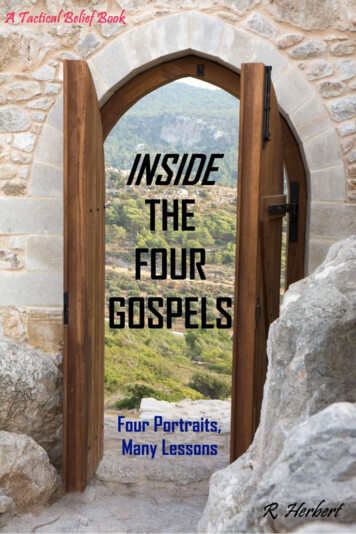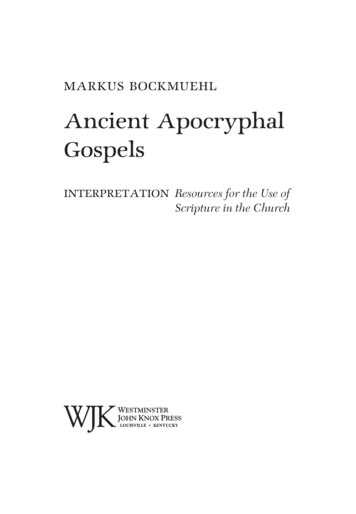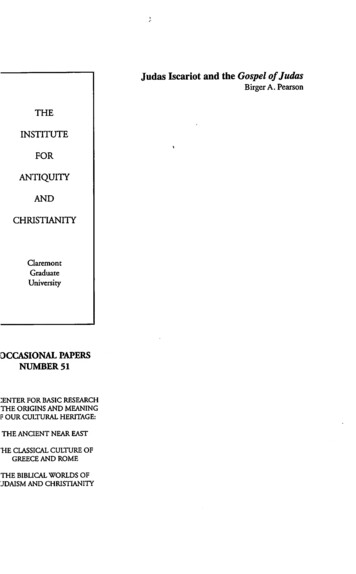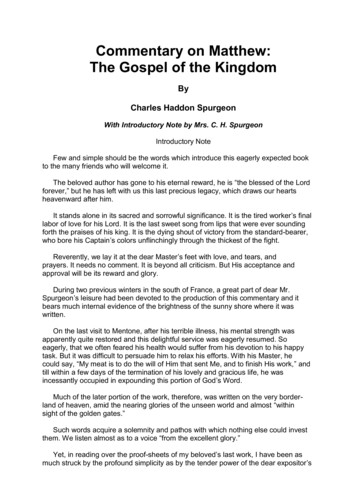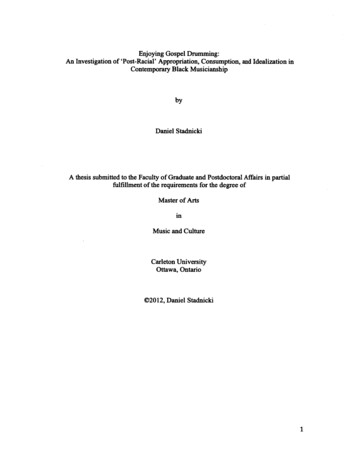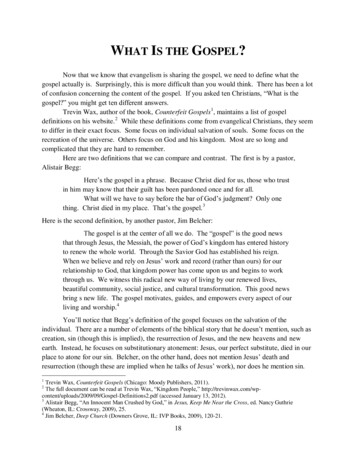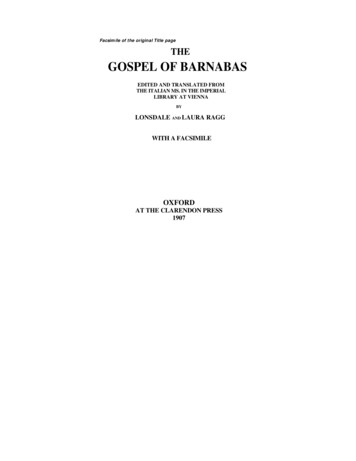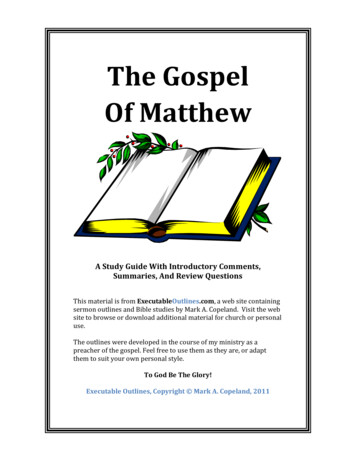
Transcription
The GospelOf MatthewA Study Guide With Introductory Comments,Summaries, And Review QuestionsThis material is from ExecutableOutlines.com, a web site containingsermon outlines and Bible studies by Mark A. Copeland. Visit the website to browse or download additional material for church or personaluse.The outlines were developed in the course of my ministry as apreacher of the gospel. Feel free to use them as they are, or adaptthem to suit your own personal style.To God Be The Glory!Executable Outlines, Copyright Mark A. Copeland, 2011
2The Gospel Of MatthewTable Of ContentsIntroductionChapter OneChapter TwoChapter ThreeChapter FourChapter FiveChapter SixChapter SevenChapter EightChapter NineChapter TenChapter ElevenChapter TwelveChapter ThirteenChapter Fourteen37891011121314151617181920Chapter FifteenChapter SixteenChapter SeventeenChapter EighteenChapter NineteenChapter TwentyChapter Twenty-OneChapter Twenty-TwoChapter Twenty-ThreeChapter Twenty-FourChapter Twenty-FiveChapter Twenty-SixChapter Twenty-SevenChapter Twenty-Eight2122232425262728293031323334This study guide was designed for adult Bible classes, though it might be suitable for juniorand senior high classes as well. Some have used it for personal devotions, and others insmall study groups. Points to ponder for each chapter are things I emphasize during the class. Review questions are intended to reinforce key thoughts in each chapter. That youmight know what answers were intended by the questions, I have included them inthis guide. There is a “student edition” available with answers deleted.ExecutableOutlines.com
3The Gospel Of MatthewIntroductionThe book of Matthew has always occupied a position of high esteem in the faith and life ofthe church:“When we turn to Matthew, we turn to the book which may well be called the most importantsingle document of the Christian faith, for in it we have the fullest and the most systematicaccount of the life and the teachings of Jesus." (William Barclay)The writings of the early church fathers reveal that it was the most frequently quoted andperhaps the most widely read gospel during the first two centuries of the church's history.AuthorThe apostolic origin and canonical rank of the gospel of Matthew were accepted without adoubt by the early church (ISBE). Matthew, surnamed Levi, had been a tax-collector, oneof Jesus' earliest disciples (Mt 9:9; Mk 2:14). He was chosen to be one of the twelveapostles (Mt 10:2-3). A close associate of Jesus during His ministry, Matthew's gospel is afirst hand account, unlike Luke who depended upon other eyewitnesses (Lk 1:1-4).DateIrenaeus says it was written when Peter and Paul were preaching in Rome (AgainstHeresies 3.1.1). Eusebius states that this was done when Matthew left Palestine and went topreach to others (Historia Ecclesiastica, III, 24). Clement of Alexandria said that thepresbyters who succeeded each other from the beginning declared that "the gospelscontaining the genealogies (Matthew and Luke) were written first" (Eusebius, HistoriaEcclesiastica, VI, 14). It is traditionally dated in the late 50s or early 60s A.D.ThemeThe gospel appears written to Jews, designed to prove that Jesus is the Messianic king of OldTestament (OT) prophecy. This is evidenced by Matthew’s frequent appeal to OT Messianicprophecies. He quotes from almost every book in the OT, and twelve times he identifies OTprophecies as fulfilled in the life of Jesus (Mt 1:22; 2:15,23; 4:14; 5:17; 8:17; 12:17;13:14,35; 21:4; 27:9). One could therefore say that the theme is:“Jesus, the King of the Jews”Special CharacteristicsIt is a Jewish gospel. We've noted its frequent appeal to OT prophecies. It's organization ismostly topical, as opposed to strictly chronological (a common style in Jewish literature).Thus it appears to have been written with a Jewish audience in mind.It is an ecclesiastical gospel. It is the only gospel which mentions the word "church". Itforetells its beginning (Mt 16:18), and describes some of the life in the church (Mt 18:1517). It contains lengthy discourses especially beneficial to those in the church, such as thesermon on the mount (Mt 5-7), the many parables (Mt 13), and the Olivet discourse (MtExecutableOutlines.com
424-25). It contains admonitions important to disciples of Christ, such as the importance ofdoing the Father's will (Mt 7:21-23) and observing all that Jesus commanded (Mt 28:20).In other words, this was a gospel designed for use by those in the early church.It is an evangelistic gospel. It is a preaching gospel, especially when compared with theapostles' preaching found in Acts. It expands upon the basic elements and points made intheir sermons. Consider these themes in apostolic preaching: God's promises in the OT have been fulfilled - Ac 3:18,24The long-awaited Messiah, born of David's line, has come - Ac 13:23He is Jesus of Nazareth - Ac 13:23He went about preaching and doing good through mighty works - Ac 10:38He was crucified according to the promise and will of God - Ac 2:22,23He was raised from the dead, and exalted at God's right hand - Ac 2:24,32-33He will come again in glory to judge the living and the dead - Ac 3:20-21; 17:30-31Therefore, all should heed His message, repent, and be baptized - Ac 2:36-38All of these points are expanded upon in the gospel of Matthew.Outline(adapted from The Wycliffe Bible Commentary)1. The birth and childhood of Jesus - Mt 1:1-2:23a. Genealogy of Christ - Mt 1:1-17b. Birth of Christ - Mt 1:18-25c. Visit of the Magi - Mt 2:1-12d. Flight into Egypt and massacre of the infants - Mt 2:13-18e. Residence at Nazareth - Mt 2:19-232. The preparation for the ministry of Jesus - Mt 3:1-4:11a. The forerunner of Christ - Mt 3:1-12b. Baptism of Christ - Mt 3:13-17c. Temptation of Christ - Mt 4:1-113. The ministry of Jesus in Galilee - Mt 4:12-18:35a. Residence at Capernaum - Mt 4:12-17b. Call of four disciples - Mt 4:18-22c. General survey of the Galilean ministry - Mt 4:23-25d. Sermon on the mount - Mt 5:1-7:29e. Ten miracles and related events - Mt 8:1-9:38f. Mission of the twelve - Mt 10:1-42g. Christ's answer to John, and related discourse - Mt 11:1-30h. Opposition from the Pharisees - Mt 12:1-50i. A series of parables on the kingdom - Mt 13:1-58j. Withdrawal of Jesus following John's beheading - Mt 14:1-36k. Conflict with the Pharisees over tradition - Mt 15:1-20l. Withdrawal to Phoenecia and healing of a Canaanitish woman's daughter- Mt 15:21-28m. Return to the Sea of Galilee and performing of miracles - Mt 15:29-38n. Renewed conflict with the Pharisees and Sadducees - Mt 15:39-16:4o. Withdrawal to the region of Caesarea Philippi - Mt 16:5-17:23ExecutableOutlines.com
5p. Instruction of the twelve at Capernaum - Mt 17:24-18:354. The ministry of Jesus in Perea - Mt 19:1-20:16a. Teaching on divorce - Mt 19:1-12b. Blessing of the children - Mt 19:13-15c. Interview with the rich young man - Mt 19:16-30d. Parable of the laborers in the vineyard - Mt 20:1-165. The ministry of Jesus in Judea - Mt 20:17-34a. Another prediction of Christ's death and resurrection - Mt 20:17-19b. Ambitious request of Zebedee's sons - Mt 20:20-28c. Healing of two blind men - Mt 20:29-346. The ministry of Jesus in Jerusalem - Mt 21:1-25:46a. Triumphal entry - Mt 21:1-11b. Cleansing the Temple - Mt 21:12-17c. Cursing of the barren fig tree - Mt 21:18-22d. Questioning of Jesus' authority and his parabolic answer - Mt 21:23-22:14e. Questioning of Jesus by various groups - Mt 22:15-46f. Jesus' public denunciation of the Pharisees - Mt 23:1-39g. Olivet Discourse - Mt 24:1-25:467. The suffering of Jesus - Mt 26:1-27:66a. Plot against Jesus - Mt 26:1-16b. The final meal - Mt 26:17-30c. Prediction of Peter's denial - Mt 26:31-35d. Events in Gethsemane - Mt 26:36-56e. Events at the Jewish trials - Mt 26:57-27:2f. Remorse of Judas - Mt 27:3-10g. Events at the Roman trials - Mt 27:11-31h. The Crucifixion - Mt 27:32-56i. Burial - Mt 27:32-568. The resurrection of Jesus - Mt 28:1-20a. Discovery of the empty tomb - Mt 28:1-8b. Appearance of Jesus Christ - Mt 28:9,10c. Report of the soldiers - Mt 28:11-15d. The great commission - Mt 28:16-20Review Questions1) Who authored the book of Matthew?- Matthew, also called Levi- An early disciple, and an apostle of Jesus Christ2) Approximately when was the book written?- The late 50s or early 60s A.D.3) What has been suggested as the theme of Matthew’s gospel?- Jesus, the King of the JewsExecutableOutlines.com
64) What three characteristics of the gospel were noted in the introduction?- It is a Jewish gospel- It is an ecclesiastical gospel- It is an evangelistic gospel5) List the eight sections of the gospel as indicated in the outline- The birth and childhood of Jesus- The preparation for the ministry of Jesus- The ministry of Jesus in Galilee- The ministry of Jesus in Perea- The ministry of Jesus in Judea- The ministry of Jesus in Jerusalem- The suffering of Jesus- The resurrection of JesusExecutableOutlines.com
7The Gospel Of MatthewChapter OneMatthew begins his gospel with the genealogy of Jesus from Abraham to Joseph. Thus heshows the royal lineage of Jesus from David, one of the first things required to convince aJewish audience that Jesus qualified to be the Messiah (1-17; cf. Mt 22:41-42). The birth ofJesus is then described, with the announcement of the angel to Joseph, and the protection ofher virginity until His birth (18-25).Points To Ponder The genealogy, comparing it with the one in Luke’s gospel The prophecies of Isaiah and the angel regarding the virgin birth The significance of the names given to the child born of MaryReview Questions1) What are the main points of this chapter?- The genealogy of Jesus Christ - Mt 1:1-17- The birth of Jesus Christ - Mt 1:18-252) Whose genealogy is given by Matthew? (1)- Jesus Christ, the son of David, the son of Abraham3) What four women are included in this genealogy? (3,5,6)- Tamar- Rahab- Ruth- The wife (Bathsheba) of Uriah4) What was the initial relationship between Joseph and Mary? (18)- Betrothed (engaged)5) When and how did Mary become pregnant? (18)- Before she and Joseph came together- From the Holy Spirit (cf. Lk 1:26-35)6) What two names would be given the child, and what do they mean? (21-23)- Jesus (savior); Immanuel (God with us)7) What scripture in the OT was fulfilled by the virgin birth of Christ? (22-23)- That written by Isaiah in Isa 7:148) How long did Joseph wait until he knew Mary as his wife? (25)- Until she had given birth to her son (Jesus)ExecutableOutlines.com
8The Gospel Of MatthewChapter TwoUnlike Luke, Matthew does not record events related to the day of Jesus’ birth. But he doesdescribe the visit of the wise men who followed the star to find the infant child and toworship Him (1-12). Warned by an angel in a dream, Joseph takes Mary and Jesus to Egypt,escaping the massacre of infants by an enraged Herod (13-18). After the death of Herod,Joseph and his family return to settle in the village of Nazareth (19-23).Points To Ponder The details of the visit of the wise men from the East Fact versus fiction related to the birth of Jesus Old Testament prophecies fulfilled by the events in this chapterReview Questions1) What are the main points of this chapter?- The visit of the wise men - Mt 2:1-12- The flight to Egypt and massacre of infants - Mt 2:13-18- The return from Egypt and residence at Nazareth - Mt 2:19-232) Why had the wise men from the East come to Jerusalem? (1-2)- They had seen the star of the King of the Jews and had come to worship Him3) How did the priests and scribes determine the location of Christ’s birth? (4-6)- From Mic 5:24) How did the wise men find the young Child? Where did they find Him? (9-11)- Heading to Bethlehem, they followed the star; in a house with Mary His mother5) Why did Joseph and his family flee? What prophecy would be fulfilled? (13-15)- Warned by an angel to go to Egypt, in order to escape Herod’s effort to destroy Jesus- “Out of Egypt I called My Son” (Hos 11:1)6) What prophecy did the slaughter of the innocents fulfill? (16-18)- That spoken by Jeremiah the prophet (Jer 31:15)7) What prompted Joseph and his family to return? Why to Galilee? (19-22)- An angel told Joseph of Herod’s death, and told him to return to Israel- Hearing that Herod’s son ruled over Judea, they turned aside to Galilee8) Where did the family settle? What prophecy did that fulfill? (23)- In a city called Nazareth- “He shall be called a Nazarene” (no one prophecy in particular)ExecutableOutlines.com
9The Gospel Of MatthewChapter ThreeMatthew skips ahead about thirty years to describe events that prepared Jesus for Hispublic ministry. John the Baptist served as a forerunner with his own ministry of preachingin the wilderness of Judea and baptizing in the Jordan river (1-12). From Galilee Jesuscame to be baptized by John “to fulfill all righteousness”. As Jesus came up out of the water,the heavens opened, the Spirit descended on Him like a dove, and a voice from heavendeclared, “This is my beloved Son in whom I am well pleased” (13-17).Points To Ponder The message and ministry of John the Baptist The purpose and meaning of Jesus’ baptismReview Questions1) What are the main points of this chapter?- The ministry of John the Baptist - Mt 3:1-12- The baptism of Jesus Christ - Mt 3:13-172) What was the theme of John’s preaching? (1-2)- “Repent, for the kingdom of heaven is at hand!”3) What was John’s mission as foretold by Isaiah? (3)- To prepare the way of the Lord (Isa 40:3)4) What unique clothing and diet did John have? (4)- Clothed in camel’s hair and leather belt, food was locust and wild honey5) What was John doing in the Jordan river? (5-6)- Baptizing people as they were confessing their sins6) What did John say to the Pharisees and Sadducees coming to be baptized? (8)- “Therefore bear fruits worthy of repentance”7) What did John say One who followed him would do? (11-12)- Baptize with the Holy Spirit and fire8) Who came from Galilee to be baptized by John? Why? (13-15)- Jesus; to fulfill all righteousness9) As Jesus came up from the water, what three things happened? (16-17)- The heavens were opened to Him- The Spirit descended like a dove upon Him- A voice from heaven said, “This is My beloved Son, in whom I am well pleased.”ExecutableOutlines.com
10The Gospel Of MatthewChapter FourFollowing His baptism, Jesus was led by the Spirit into the wilderness where He fasted forforty days and overcame temptation by the devil (1-11). Returning to Galilee and movingfrom Nazareth to Capernaum, Jesus began His Galilean ministry preaching the samemessage of the kingdom of heaven as that of John the Baptist. After selecting four disciples,Jesus went about Galilee teaching in the synagogues and healing all kinds of sickness anddisease. Soon great multitudes from surrounding regions began to follow Him (12-25).Points To Ponder How Jesus overcame His temptation by the devil The beginning of His ministry in Galilee, His message and methods The call of Peter, Andrew, James, and John to discipleshipReview Questions1) What are the main points of this chapter?- The temptation of Jesus - Mt 4:1-11- The beginning of Jesus’ Galilean ministry - Mt 4:12-252) With what three temptations did Satan challenge Jesus? (3,6,9)- “If you are the Son of God, command that these stones become bread.”- “If you are the Son of God, throw yourself down (from the pinnacle of the temple).”- “All these things (kingdoms of the world) I will give You if You will fall down andworship me.”3) How did Jesus respond to each of the three temptations? (4,7,10)- With the Word of God (“It is written ”)4) Where did Jesus begin His public ministry? Fulfilling what prophecy? (12-16)- The region of Galilee; as prophesied by Isaiah (Isa 9:1-2)5) What was the theme of Jesus’ preaching? (17)- “The kingdom of heaven is at hand.”6) Who were the four fishermen called to follow Jesus? (18-22)- Peter and Andrew, James and John7) How did Jesus conduct His ministry in Galilee? (23-24)- Teaching in the synagogues- Healing all kinds of disease and sickness, including demon possession8) Where did people come from to follow Jesus? (25)- Galilee, Decapolis, Jerusalem, Judea, and beyond the JordanExecutableOutlines.com
11The Gospel Of MatthewChapter FiveBeginning in this chapter, Matthew records the “Sermon On The Mount”. The theme of thesermon is “The kingdom of heaven” (cf. Mt 4:17; 5:3,10,19-20; 6:10,33; 7:21). Jesus beganwith “The Beatitudes,” describing the character and blessedness of those who would becitizens of the kingdom (1-12) and illustrating their relation to world as salt and light (1316). Clarifying His own relationship with the Law, Jesus stressed how our righteousnessmust surpass that of the scribes and Pharisees (17-20) following with a series of contrastsbetween the oral interpretations of the Law and conduct expected of His disciples (21-48).Points To Ponder The meaning of the phrase: “the kingdom of heaven” The blessedness of those in the kingdom, and their relationship to the world How our righteousness must surpass that of the scribes and PhariseesReview Questions1) What are the main points of this chapter?- The beatitudes - Mt 5:1-12- Salt and light - Mt 5:13-16- Jesus and the Law - Mt 5:17-20- Interpretations of the Law versus kingdom righteousness - Mt 5:21-482) What do the beatitudes describe? (3-12)- The character and blessedness of the citizens of the kingdom3) How are citizens of the kingdom to relate to the world? (13-16)- As the salt of the earth and the light of the world4) What was Jesus’ relation to the Law of Moses? (17-18)- He came not to destroy the Law, but to fulfill it5) What does Jesus expect of those who would be citizens of the kingdom? (20)- Righteousness that surpasses that of the scribes and Pharisees6) List the five subjects whose interpretations are contrasted in this chapter (21-48)- Murder, adultery, oaths, retaliation, love7) What phrases illustrate the contrast? (21-22,27-28,31-32,33-34,38-39,43-44)- “You have heard that it was said ” (not “It is written ”)- “But I say to you ”8) Then what contrast is being made with these five subjects?- The oral interpretation and application of the Law versus the teaching of JesusExecutableOutlines.com
12The Gospel Of MatthewChapter SixThe “Sermon On The Mount” continues as Jesus teaches the righteousness of the kingdomexpected in those who would be citizens of the kingdom. He discusses righteousness withrespect to man’s relation to God, regarding charitable deeds (1-4), prayer (5-15), fasting(16-18), materialism (19-24), and anxiety (25-33).Points To Ponder Performing acts of righteousness in ways that please God The danger of materialism and overcoming anxiety about such things Making the kingdom of God and His righteousness our number one priorityReview Questions1) What are the main points of this chapter?- Righteousness with respect to man’s relation to God - Mt 6:1-18- Overcoming materialism and anxiety - Mt 6:16-332) As we perform acts of righteousness, what should we avoid? (1-2,5,16)- Doing it for the purpose of being seen by men- Acting like the hypocrites in the synagogues and in the streets3) How can we ensure that God will reward us for our righteous acts? (4,6,18)- By doing them in secret where only the Father sees4) How else does Jesus teach us to give, pray, and fast? (3,7,17)- Do not let our left hand know what our right hand is doing as we give- Do not use vain repetition as we pray- Do not disfigure our faces as we fast5) What is the likely purpose of “The Lord’s Prayer”? (9-13)- To serve as a model of prayer (“In this manner ”)6) Of things in “The Lord’s Prayer,” on what does Jesus elaborate? (14-15)- The need for us to forgive others their trespasses against us7) Where are we to lay up treasure? Why? How? (20,24; cf. Mt 19:21; 1Ti 6:17-19)- In heaven; to serve God rather than mammon; by giving to the poor8) What is the key to overcoming anxiety? (25-32)- Trusting in the providential care of God9) How can we ensure that God will provide what we need? (33)- By seeking first the kingdom of God and His righteousnessExecutableOutlines.com
13The Gospel Of MatthewChapter SevenThe “Sermon On The Mount” continues with Jesus discussing the righteousness of thekingdom with respect to man’s relation to man, with a warning regarding judging (1-6),the importance of persistence (7-11), and keeping “the golden rule” (12). It concludes withexhortations to enter the kingdom: choose the narrow and difficult path (13-14), watch outfor false prophets (15-20), do the Father’s will (21-23), being doers of the Word (24-29).Points To Ponder The nature of judging condemned by Jesus How Jesus’ “golden rule” differs from that found in other religions The importance of doing the Father’s will to being savedReview Questions1) What are the main points of this chapter?- Righteousness with respect to man’s relation to man - Mt 7:1-12- Exhortations to enter the kingdom - Mt 7:15-292) What sort of judging is Jesus warning against? (1-6)- Not all judging, but hypocritical, censorious condemnation (cf. Jn 7:24)3) How does Jesus illustrate the need for persistence? (7-11)- By literally saying “keep on” asking, seeking, knocking4) How does Jesus’ “golden rule” differ from that found in other religions? (12)- Most state it negatively (“Don’t do to others what you don’t want done to you”)5) Contrast the two “ways” described by Jesus (13-14)- The way to life: narrow gate and difficult way, found by few- The way to destruction: wide gate and broad way, traveled by many6) How do false prophets operate? How can we identify them? (15-20)- As wolves in sheep’s clothing; by their fruits7) Who will not enter the kingdom of heaven? Who will? (21-23)- Many who believed in the Lord, did many great things for Him, but practicedlawlessness (i.e., did things without His authority)- Those who do the will of His Father in heaven8) What is the key difference between the wise and foolish listeners? (24-27)- The wise do what Jesus said, the foolish do not9) Why were the people astonished at Jesus’ teaching? (28-29)- Because He taught as one having authorityExecutableOutlines.com
14The Gospel Of MatthewChapter EightAs Jesus’ ministry in Galilee continues, Matthew describes several miracles and relatedevents. Coming down from the mount, Jesus cleansed a leper (1-4). Entering Capernaum,He healed a centurion’s servant (5-13). Arriving at Peter’s house, He healed his mother-inlaw and many demon-possessed and all who were sick (14-17). Before crossing the Sea ofGalilee to escape large crowds, Jesus challenged two would-be disciples (18-22). Aftercalming the winds and waves of a great tempest (23-27), He arrived on the other side of thesea where He healed two demon-possessed men (28-34).Points To Ponder The nature and purpose of the miracles performed by Jesus The cost of discipleshipReview Questions1) What are the main points of this chapter?- Five miracles in the regions of Galilee and the Gergesenes - Mt 8:1-17,23-34- The cost of discipleship - Mt 8:18-222) List the five miracles recorded in this chapter (1-4,5-13,14-17,23-27,28-34)- Jesus cleanses a leper- Jesus heals a centurion’s servant- Jesus heals Peter’s mother-in-law (and many others)- Jesus calms the wind and the waves- Jesus heals two demon-possessed men3) Before healing the centurion’s servant, what impressed Jesus? (10)- The great faith of the centurion who was a Gentile4) Before healing the servant, what did Jesus foretell? (11-12)- Gentiles would enter the kingdom, while many Israelites would not5) In Peter’s house, who did Jesus heal? What prophecy was fulfilled? (14-17)- His mother-in-law, and all the sick that were brought to Him- “He Himself took our infirmities And bore our sicknesses” - Isa 53:46) What two lessons did Jesus teach about discipleship? (19-22)- It can mean a life of poverty; it requires precedence over familial duties7) What can we learn about fear and faith, before Jesus calmed the sea? (25-26)- Fear comes from having little faith8) Who did the demons acknowledge Jesus to be as He confronted them? (29)- The Son of GodExecutableOutlines.com
15The Gospel Of MatthewChapter NineBack in Capernaum, Jesus’ ministry in Galilee continued with both forgiving and healing aparalytic (1-8). Matthew the tax collector was called to be a disciple, who invited Jesus tohis home where He was questioned by the Pharisees and disciples of John (9-17). Asked bya ruler to go and raise his dead daughter, Jesus did so, healing a woman with a flow alongthe way (18-26). Afterward Jesus healed two blind men and a man who was both mute anddemon-possessed (27-34). He then went about the region, teaching and healing, movedwith compassion for the multitudes that came to Him (35-38).Points To Ponder Jesus’ power to forgive sins His willingness to eat with sinners His compassion for the lostReview Questions1) What are the main points of this chapter?- Five miracles in Capernaum of Galilee - Mt 9:1-8,18-34- The call of Matthew and the questions at his house - Mt 9:9-17- The itinerant teaching and healing in cities and villages - Mt 9:35-382) List the five miracles recorded in this chapter (1-8,18-34)- Jesus forgives and heals a paralytic- Jesus heals a woman with a flow of blood- Jesus restores a ruler’s daughter to life- Jesus heals two blind men- Jesus heals a man mute and demon-possessed3) How did Jesus demonstrate His power to forgive sins? (6)- By healing a paralytic4) Who was called to be a disciple and then gave a feast at his house? (9-10)- Matthew, also known as Levi, author of this gospel (cf. Lk 5:27-29)5) What two groups confronted Jesus regarding what two issues? (11-17)- The Pharisees, concerning eating with sinners- The disciples of John, concerning fasting6) What explanation did Pharisees give for Jesus’ ability to exorcise demons? (34)- “He casts out demons by the ruler of the demons.”7) What moved Jesus to call for prayer for more laborers? (36-38)- Compassion for the multitudes who were like sheep without a shepherdExecutableOutlines.com
16The Gospel Of MatthewChapter TenFollowing His own call for prayer for more laborers (Mt 9:37-38), Jesus selected twelvedisciples to be His apostles and gave them power to cast out demons and heal all kinds ofdisease (1-4). He then sent them to preach and heal throughout the cities of Israel withspecific instructions in what has come to be called “The Limited Commission” (5-42).Points To Ponder The twelve men selected to be Jesus’ apostles Evangelistic principles utilized by JesusReview Questions1) What are the main points of this chapter?- The appointment of the twelve apostles - Mt 10:1-4- Instructions for the twelve for the limited commission - Mt 10:5-422) List the names of the twelve apostles (2-4)- Peter and Andrew, James and John, Philip, Bartholomew, Thomas, Matthew, James theson of Alphaeus, Labbaeus surnamed Thaddaeus, Simon the Cananite, Judas Iscariot3) What was to be the range of their preaching? Their message? (5-7)- Only to the house of Israel; “The kingdom of heaven is at hand”4) What miracles were they to perform as they preached? At what charge? (8)- Heal the sick, cleanse the lepers, raise the dead, cast out demons- No charge for their services (“Freely you have received, freely give”)5) How were they to be supported? (9-11)- By people willing to receive them into their homes6) What were they to do if they were not received by a house or city? (14-15)- Depart, shaking the dust from their feet7) What did Jesus prepare them to expect? (16-26)- Persecution8) What were they to fear more than persecution? (28,33)- Him who is able to destroy both soul and body in hell; being denied by the Lord9) What did Jesus acknowledge His teachings might do? (34-36)- Separate members of the same family10) What blessings would befall those who assisted the apostles? (41-42)- The same reward for their serviceExecutableOutlines.com
17The Gospel Of MatthewChapter ElevenWhile the apostles were fulfilling the limited commission, Jesus was approached byemissaries from John the Baptist who received confirmation that He was “The Coming One”(1-6). Jesus revealed that John was “The Messenger” foretold by Malachai and that manywere inconsistent in their opposition to both Jesus and John (7-19). Jesus then rebukedcities which did not repent at His teaching (20-24), and at the same time extended a tenderinvitation to those who would accept His teaching (25-30).Points To Ponder The relationship between Jesus and John the Baptist Why the day of judgment will be more tolerable for Tyre, Sidon, and Sodom than itwill be for Chorazin, Bethsaida, and Capernaum The Savior’s tender invitation to those with troubled soulsReview Questions1) What are the main points of this chapter?- John’s disciples come to Jesus - Mt 11:1-6- Jesus’ discourse regarding John the Baptist - Mt 11:7-19- Woe to impenitent cities - Mt 11:20-24- The Savior’s prayer and tender invitation - Mt 11:25-302) Why did John send two disciples to Jesus? (2-3)- To confirm that Jesus was “The Coming One”3) What evidence did Jesus offer to John’s disciples? (4-5)- His miracles, and the fact that the poor have the gospel preached to them4) What two O.T. prophecies did Jesus say that John fulfilled? (10,14)- Mal 3:1 and Mal 4:55) Who did Jesus say would be greater than John the Baptist? (11)- He who is least in the kingdom of heaven6) How did some people describe John and Jesus? (18-19)- John: having a demon- Jesus: a glutton, winebibber, and friend of sinners and tax collectors7) Why did Jesus rebuke the cities of Chorazin, Bethsaida, and Capernaum? (20)- Because they saw His might works and yet did not repent8) To whom did Jesus extend His invitation? What did He expect in return? (28-30)- To all who labor and are heavy laden (by the guilt of sin)- To take His yoke upon them and learn from Him (become His disciple)ExecutableOutlines.com
18The Gospel Of Matt
The book of Matthew has always occupied a position of high esteem in the faith and life of the church: “When we turn to Matthew, we turn to the book which may well be called the most important single document of the Christian faith, for in it we have the fullest and the most sy
